Strategic HRM Analysis: Current Trends and Factors at TESCO Ltd.
VerifiedAdded on 2023/01/10
|14
|4084
|37
Report
AI Summary
This report provides a comprehensive analysis of strategic human resource management (HRM) at TESCO Ltd. It begins by identifying current developments and trends influencing HR strategy, such as globalization, diversity, constant improvement, dynamic skills requirements, and career management. The report then explores the impact of both external factors (laws, technology) and internal factors (employee relations, internal policies) on TESCO's HRM strategy. It further examines the growth of strategic HRM through concepts like contingency theory, performance management, e-recruitment, and 540-degree performance appraisal. The role of change management models, specifically Lewin's model, in assisting HR strategy is also discussed. Finally, the report evaluates HR outcomes and the importance of effective HR management in achieving sustainable business performance and organizational goals. The report concludes by highlighting the significance of aligning HR strategies with organizational objectives to drive success.
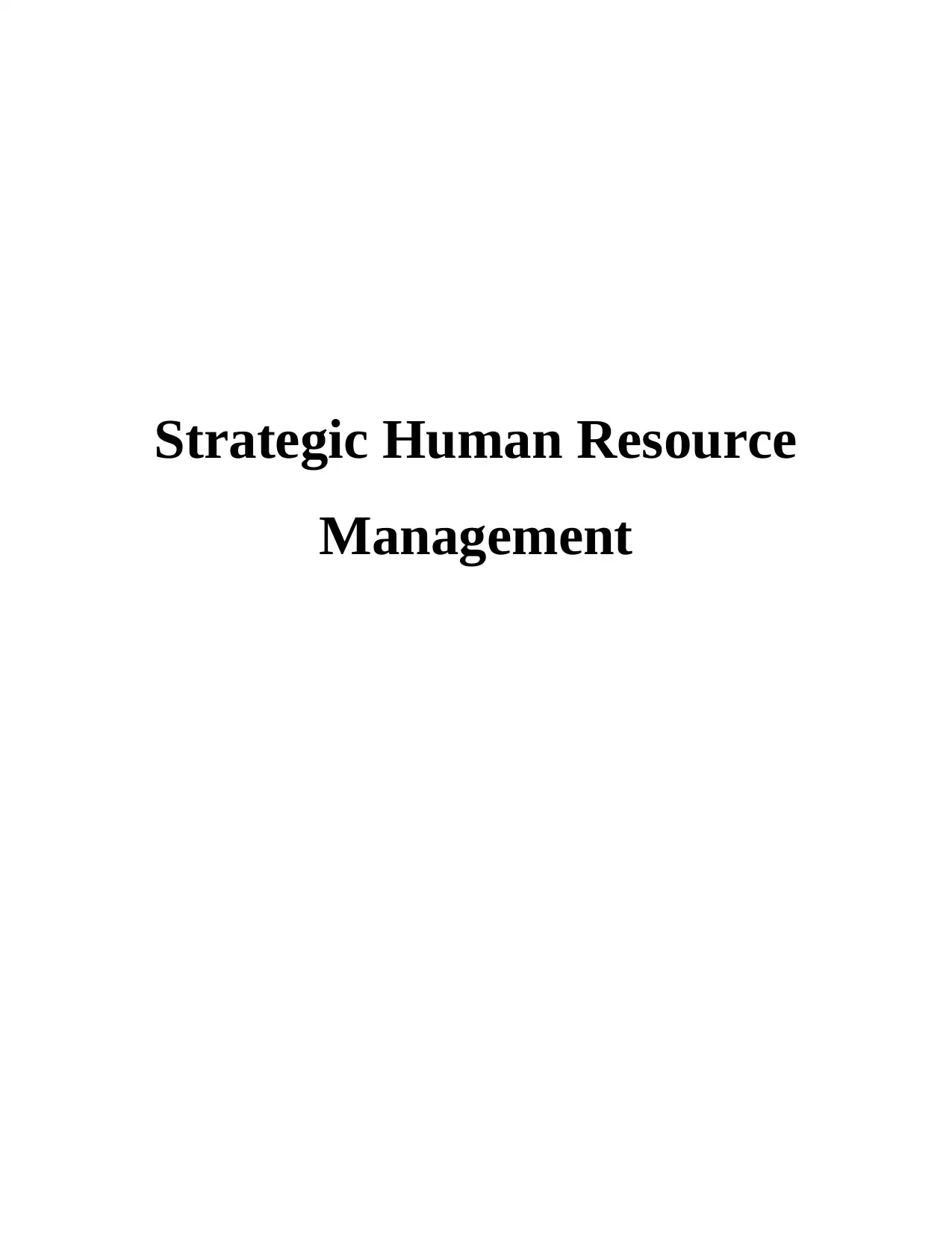
Strategic Human Resource
Management
Management
Paraphrase This Document
Need a fresh take? Get an instant paraphrase of this document with our AI Paraphraser
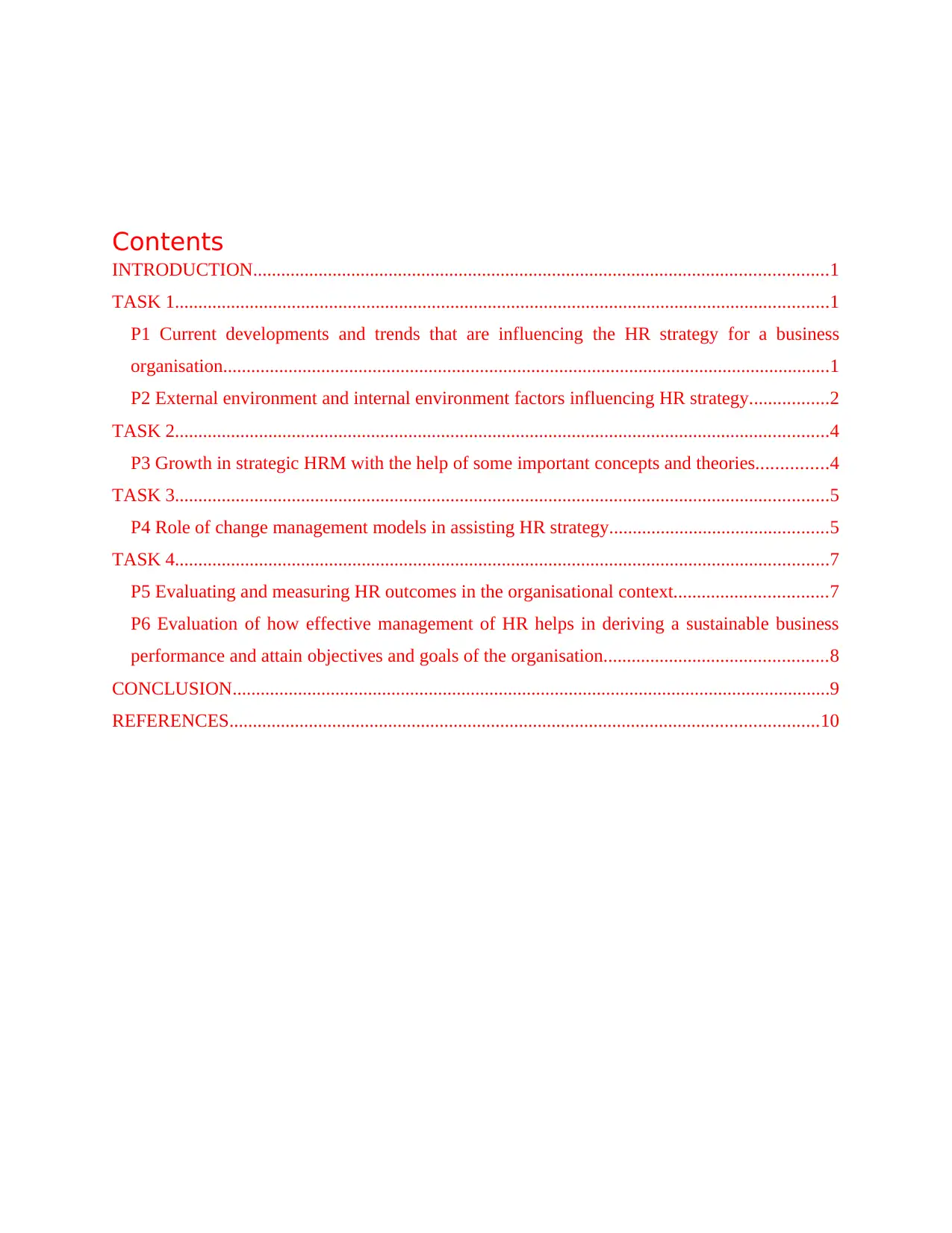
Contents
INTRODUCTION...........................................................................................................................1
TASK 1............................................................................................................................................1
P1 Current developments and trends that are influencing the HR strategy for a business
organisation..................................................................................................................................1
P2 External environment and internal environment factors influencing HR strategy.................2
TASK 2............................................................................................................................................4
P3 Growth in strategic HRM with the help of some important concepts and theories...............4
TASK 3............................................................................................................................................5
P4 Role of change management models in assisting HR strategy...............................................5
TASK 4............................................................................................................................................7
P5 Evaluating and measuring HR outcomes in the organisational context.................................7
P6 Evaluation of how effective management of HR helps in deriving a sustainable business
performance and attain objectives and goals of the organisation................................................8
CONCLUSION................................................................................................................................9
REFERENCES..............................................................................................................................10
INTRODUCTION...........................................................................................................................1
TASK 1............................................................................................................................................1
P1 Current developments and trends that are influencing the HR strategy for a business
organisation..................................................................................................................................1
P2 External environment and internal environment factors influencing HR strategy.................2
TASK 2............................................................................................................................................4
P3 Growth in strategic HRM with the help of some important concepts and theories...............4
TASK 3............................................................................................................................................5
P4 Role of change management models in assisting HR strategy...............................................5
TASK 4............................................................................................................................................7
P5 Evaluating and measuring HR outcomes in the organisational context.................................7
P6 Evaluation of how effective management of HR helps in deriving a sustainable business
performance and attain objectives and goals of the organisation................................................8
CONCLUSION................................................................................................................................9
REFERENCES..............................................................................................................................10

⊘ This is a preview!⊘
Do you want full access?
Subscribe today to unlock all pages.

Trusted by 1+ million students worldwide
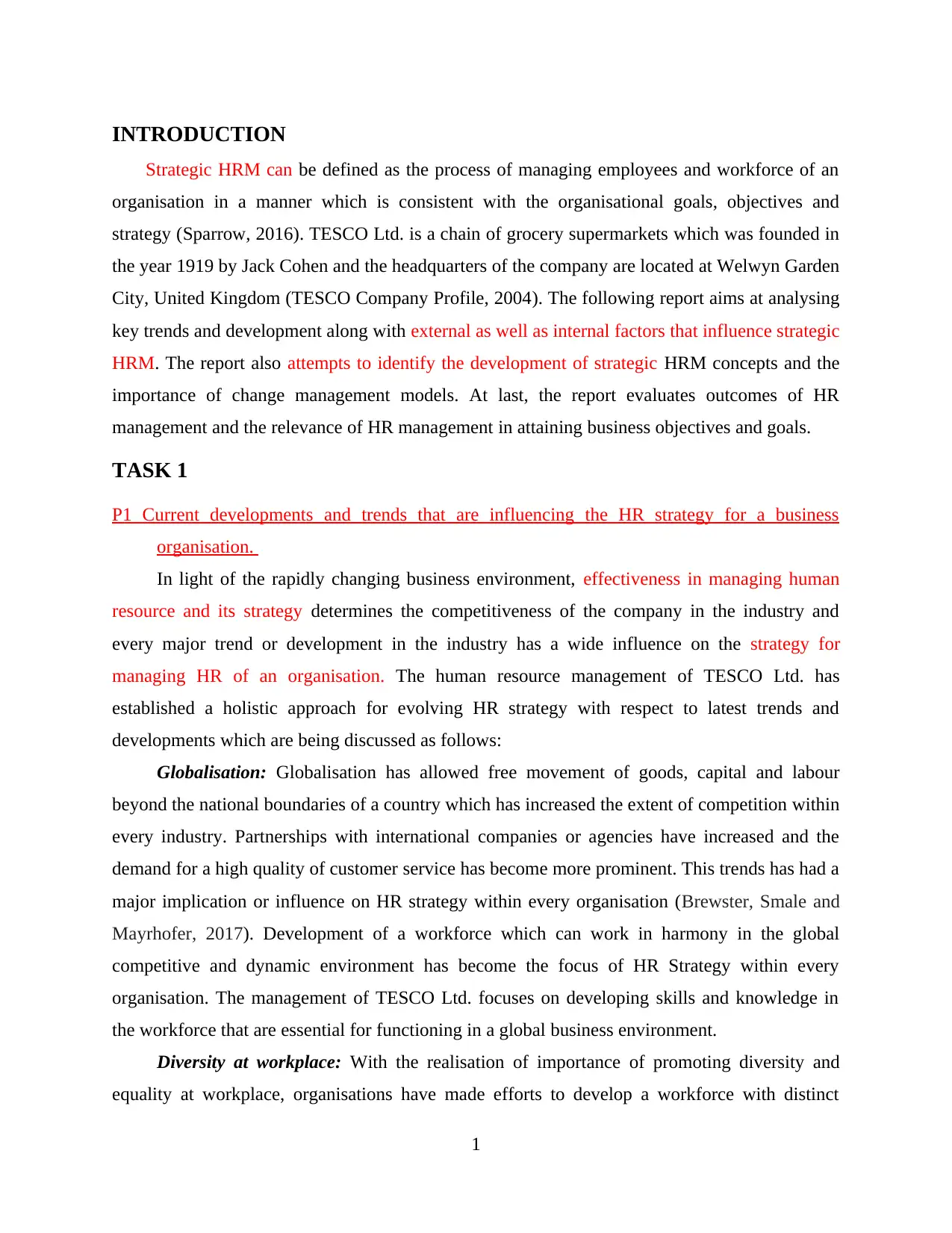
INTRODUCTION
Strategic HRM can be defined as the process of managing employees and workforce of an
organisation in a manner which is consistent with the organisational goals, objectives and
strategy (Sparrow, 2016). TESCO Ltd. is a chain of grocery supermarkets which was founded in
the year 1919 by Jack Cohen and the headquarters of the company are located at Welwyn Garden
City, United Kingdom (TESCO Company Profile, 2004). The following report aims at analysing
key trends and development along with external as well as internal factors that influence strategic
HRM. The report also attempts to identify the development of strategic HRM concepts and the
importance of change management models. At last, the report evaluates outcomes of HR
management and the relevance of HR management in attaining business objectives and goals.
TASK 1
P1 Current developments and trends that are influencing the HR strategy for a business
organisation.
In light of the rapidly changing business environment, effectiveness in managing human
resource and its strategy determines the competitiveness of the company in the industry and
every major trend or development in the industry has a wide influence on the strategy for
managing HR of an organisation. The human resource management of TESCO Ltd. has
established a holistic approach for evolving HR strategy with respect to latest trends and
developments which are being discussed as follows:
Globalisation: Globalisation has allowed free movement of goods, capital and labour
beyond the national boundaries of a country which has increased the extent of competition within
every industry. Partnerships with international companies or agencies have increased and the
demand for a high quality of customer service has become more prominent. This trends has had a
major implication or influence on HR strategy within every organisation (Brewster, Smale and
Mayrhofer, 2017). Development of a workforce which can work in harmony in the global
competitive and dynamic environment has become the focus of HR Strategy within every
organisation. The management of TESCO Ltd. focuses on developing skills and knowledge in
the workforce that are essential for functioning in a global business environment.
Diversity at workplace: With the realisation of importance of promoting diversity and
equality at workplace, organisations have made efforts to develop a workforce with distinct
1
Strategic HRM can be defined as the process of managing employees and workforce of an
organisation in a manner which is consistent with the organisational goals, objectives and
strategy (Sparrow, 2016). TESCO Ltd. is a chain of grocery supermarkets which was founded in
the year 1919 by Jack Cohen and the headquarters of the company are located at Welwyn Garden
City, United Kingdom (TESCO Company Profile, 2004). The following report aims at analysing
key trends and development along with external as well as internal factors that influence strategic
HRM. The report also attempts to identify the development of strategic HRM concepts and the
importance of change management models. At last, the report evaluates outcomes of HR
management and the relevance of HR management in attaining business objectives and goals.
TASK 1
P1 Current developments and trends that are influencing the HR strategy for a business
organisation.
In light of the rapidly changing business environment, effectiveness in managing human
resource and its strategy determines the competitiveness of the company in the industry and
every major trend or development in the industry has a wide influence on the strategy for
managing HR of an organisation. The human resource management of TESCO Ltd. has
established a holistic approach for evolving HR strategy with respect to latest trends and
developments which are being discussed as follows:
Globalisation: Globalisation has allowed free movement of goods, capital and labour
beyond the national boundaries of a country which has increased the extent of competition within
every industry. Partnerships with international companies or agencies have increased and the
demand for a high quality of customer service has become more prominent. This trends has had a
major implication or influence on HR strategy within every organisation (Brewster, Smale and
Mayrhofer, 2017). Development of a workforce which can work in harmony in the global
competitive and dynamic environment has become the focus of HR Strategy within every
organisation. The management of TESCO Ltd. focuses on developing skills and knowledge in
the workforce that are essential for functioning in a global business environment.
Diversity at workplace: With the realisation of importance of promoting diversity and
equality at workplace, organisations have made efforts to develop a workforce with distinct
1
Paraphrase This Document
Need a fresh take? Get an instant paraphrase of this document with our AI Paraphraser
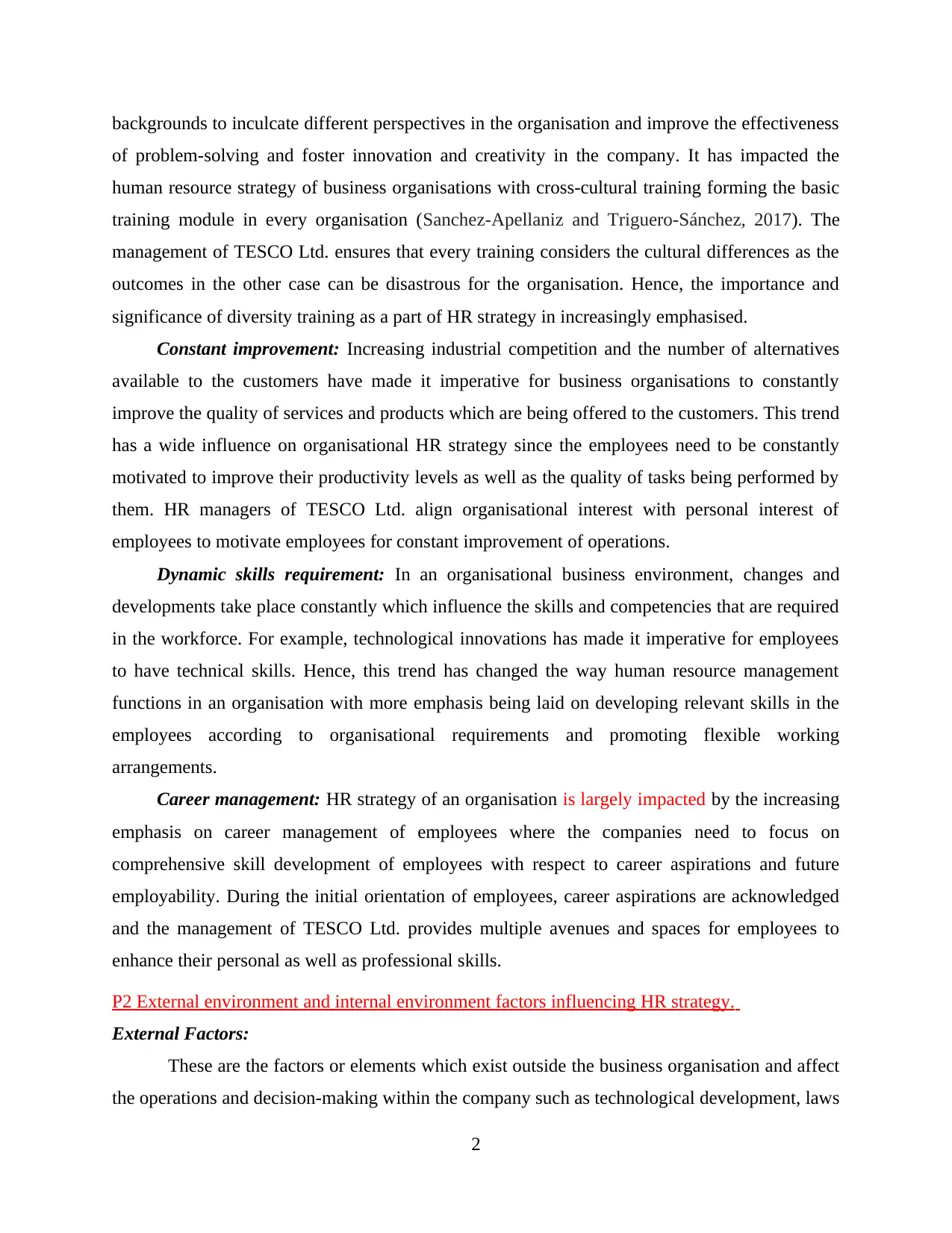
backgrounds to inculcate different perspectives in the organisation and improve the effectiveness
of problem-solving and foster innovation and creativity in the company. It has impacted the
human resource strategy of business organisations with cross-cultural training forming the basic
training module in every organisation (Sanchez-Apellaniz and Triguero-Sánchez, 2017). The
management of TESCO Ltd. ensures that every training considers the cultural differences as the
outcomes in the other case can be disastrous for the organisation. Hence, the importance and
significance of diversity training as a part of HR strategy in increasingly emphasised.
Constant improvement: Increasing industrial competition and the number of alternatives
available to the customers have made it imperative for business organisations to constantly
improve the quality of services and products which are being offered to the customers. This trend
has a wide influence on organisational HR strategy since the employees need to be constantly
motivated to improve their productivity levels as well as the quality of tasks being performed by
them. HR managers of TESCO Ltd. align organisational interest with personal interest of
employees to motivate employees for constant improvement of operations.
Dynamic skills requirement: In an organisational business environment, changes and
developments take place constantly which influence the skills and competencies that are required
in the workforce. For example, technological innovations has made it imperative for employees
to have technical skills. Hence, this trend has changed the way human resource management
functions in an organisation with more emphasis being laid on developing relevant skills in the
employees according to organisational requirements and promoting flexible working
arrangements.
Career management: HR strategy of an organisation is largely impacted by the increasing
emphasis on career management of employees where the companies need to focus on
comprehensive skill development of employees with respect to career aspirations and future
employability. During the initial orientation of employees, career aspirations are acknowledged
and the management of TESCO Ltd. provides multiple avenues and spaces for employees to
enhance their personal as well as professional skills.
P2 External environment and internal environment factors influencing HR strategy.
External Factors:
These are the factors or elements which exist outside the business organisation and affect
the operations and decision-making within the company such as technological development, laws
2
of problem-solving and foster innovation and creativity in the company. It has impacted the
human resource strategy of business organisations with cross-cultural training forming the basic
training module in every organisation (Sanchez-Apellaniz and Triguero-Sánchez, 2017). The
management of TESCO Ltd. ensures that every training considers the cultural differences as the
outcomes in the other case can be disastrous for the organisation. Hence, the importance and
significance of diversity training as a part of HR strategy in increasingly emphasised.
Constant improvement: Increasing industrial competition and the number of alternatives
available to the customers have made it imperative for business organisations to constantly
improve the quality of services and products which are being offered to the customers. This trend
has a wide influence on organisational HR strategy since the employees need to be constantly
motivated to improve their productivity levels as well as the quality of tasks being performed by
them. HR managers of TESCO Ltd. align organisational interest with personal interest of
employees to motivate employees for constant improvement of operations.
Dynamic skills requirement: In an organisational business environment, changes and
developments take place constantly which influence the skills and competencies that are required
in the workforce. For example, technological innovations has made it imperative for employees
to have technical skills. Hence, this trend has changed the way human resource management
functions in an organisation with more emphasis being laid on developing relevant skills in the
employees according to organisational requirements and promoting flexible working
arrangements.
Career management: HR strategy of an organisation is largely impacted by the increasing
emphasis on career management of employees where the companies need to focus on
comprehensive skill development of employees with respect to career aspirations and future
employability. During the initial orientation of employees, career aspirations are acknowledged
and the management of TESCO Ltd. provides multiple avenues and spaces for employees to
enhance their personal as well as professional skills.
P2 External environment and internal environment factors influencing HR strategy.
External Factors:
These are the factors or elements which exist outside the business organisation and affect
the operations and decision-making within the company such as technological development, laws
2
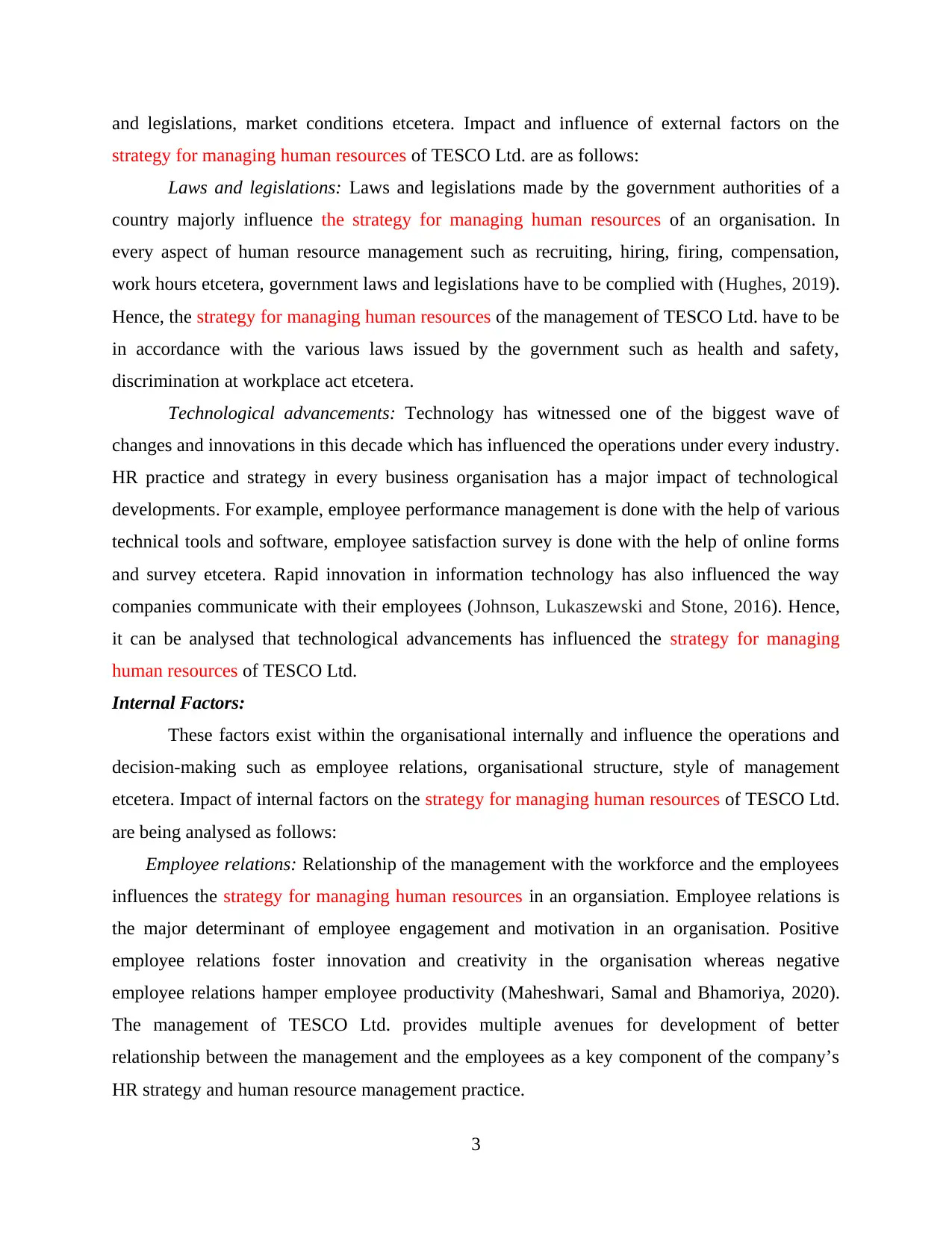
and legislations, market conditions etcetera. Impact and influence of external factors on the
strategy for managing human resources of TESCO Ltd. are as follows:
Laws and legislations: Laws and legislations made by the government authorities of a
country majorly influence the strategy for managing human resources of an organisation. In
every aspect of human resource management such as recruiting, hiring, firing, compensation,
work hours etcetera, government laws and legislations have to be complied with (Hughes, 2019).
Hence, the strategy for managing human resources of the management of TESCO Ltd. have to be
in accordance with the various laws issued by the government such as health and safety,
discrimination at workplace act etcetera.
Technological advancements: Technology has witnessed one of the biggest wave of
changes and innovations in this decade which has influenced the operations under every industry.
HR practice and strategy in every business organisation has a major impact of technological
developments. For example, employee performance management is done with the help of various
technical tools and software, employee satisfaction survey is done with the help of online forms
and survey etcetera. Rapid innovation in information technology has also influenced the way
companies communicate with their employees (Johnson, Lukaszewski and Stone, 2016). Hence,
it can be analysed that technological advancements has influenced the strategy for managing
human resources of TESCO Ltd.
Internal Factors:
These factors exist within the organisational internally and influence the operations and
decision-making such as employee relations, organisational structure, style of management
etcetera. Impact of internal factors on the strategy for managing human resources of TESCO Ltd.
are being analysed as follows:
Employee relations: Relationship of the management with the workforce and the employees
influences the strategy for managing human resources in an organsiation. Employee relations is
the major determinant of employee engagement and motivation in an organisation. Positive
employee relations foster innovation and creativity in the organisation whereas negative
employee relations hamper employee productivity (Maheshwari, Samal and Bhamoriya, 2020).
The management of TESCO Ltd. provides multiple avenues for development of better
relationship between the management and the employees as a key component of the company’s
HR strategy and human resource management practice.
3
strategy for managing human resources of TESCO Ltd. are as follows:
Laws and legislations: Laws and legislations made by the government authorities of a
country majorly influence the strategy for managing human resources of an organisation. In
every aspect of human resource management such as recruiting, hiring, firing, compensation,
work hours etcetera, government laws and legislations have to be complied with (Hughes, 2019).
Hence, the strategy for managing human resources of the management of TESCO Ltd. have to be
in accordance with the various laws issued by the government such as health and safety,
discrimination at workplace act etcetera.
Technological advancements: Technology has witnessed one of the biggest wave of
changes and innovations in this decade which has influenced the operations under every industry.
HR practice and strategy in every business organisation has a major impact of technological
developments. For example, employee performance management is done with the help of various
technical tools and software, employee satisfaction survey is done with the help of online forms
and survey etcetera. Rapid innovation in information technology has also influenced the way
companies communicate with their employees (Johnson, Lukaszewski and Stone, 2016). Hence,
it can be analysed that technological advancements has influenced the strategy for managing
human resources of TESCO Ltd.
Internal Factors:
These factors exist within the organisational internally and influence the operations and
decision-making such as employee relations, organisational structure, style of management
etcetera. Impact of internal factors on the strategy for managing human resources of TESCO Ltd.
are being analysed as follows:
Employee relations: Relationship of the management with the workforce and the employees
influences the strategy for managing human resources in an organsiation. Employee relations is
the major determinant of employee engagement and motivation in an organisation. Positive
employee relations foster innovation and creativity in the organisation whereas negative
employee relations hamper employee productivity (Maheshwari, Samal and Bhamoriya, 2020).
The management of TESCO Ltd. provides multiple avenues for development of better
relationship between the management and the employees as a key component of the company’s
HR strategy and human resource management practice.
3
⊘ This is a preview!⊘
Do you want full access?
Subscribe today to unlock all pages.

Trusted by 1+ million students worldwide
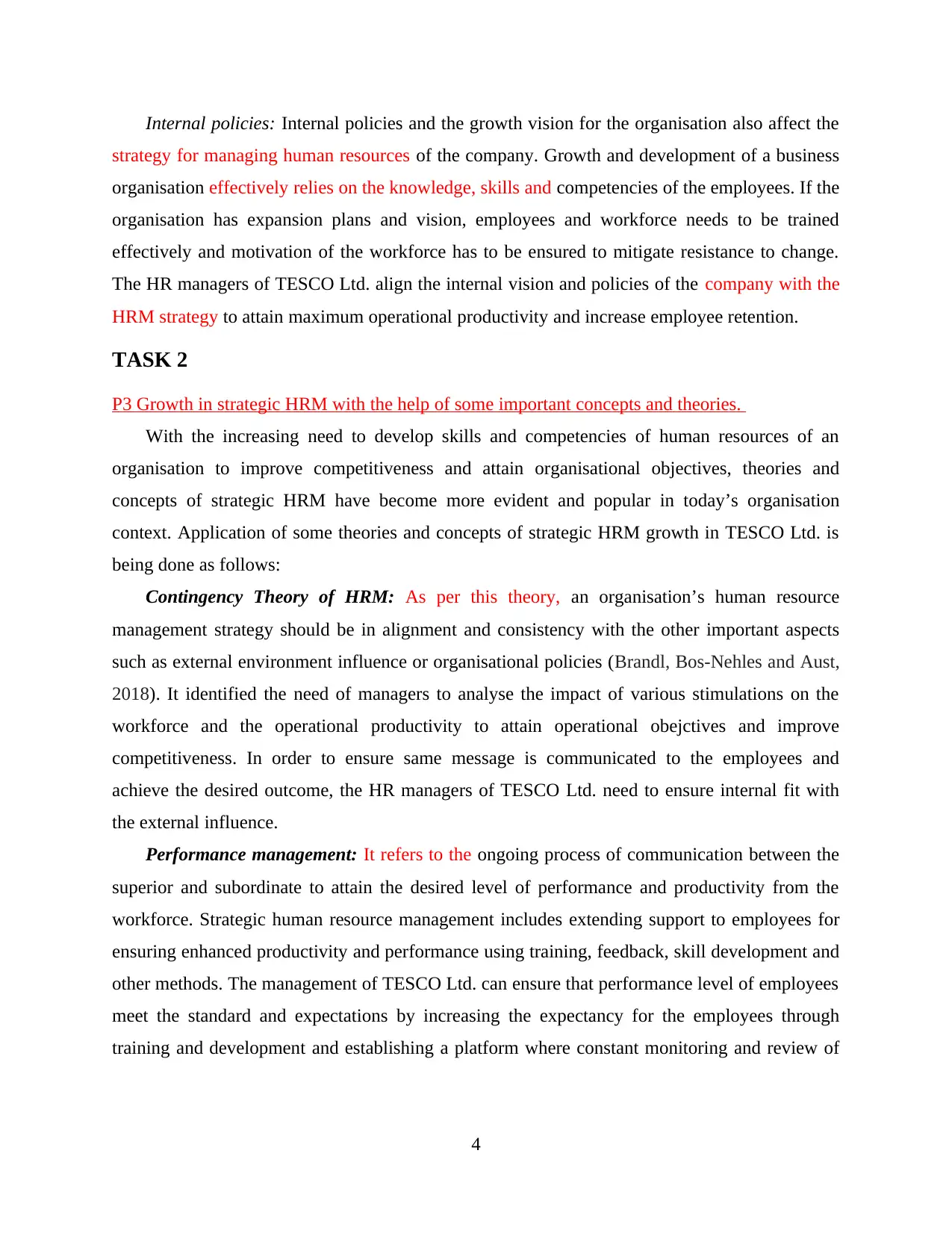
Internal policies: Internal policies and the growth vision for the organisation also affect the
strategy for managing human resources of the company. Growth and development of a business
organisation effectively relies on the knowledge, skills and competencies of the employees. If the
organisation has expansion plans and vision, employees and workforce needs to be trained
effectively and motivation of the workforce has to be ensured to mitigate resistance to change.
The HR managers of TESCO Ltd. align the internal vision and policies of the company with the
HRM strategy to attain maximum operational productivity and increase employee retention.
TASK 2
P3 Growth in strategic HRM with the help of some important concepts and theories.
With the increasing need to develop skills and competencies of human resources of an
organisation to improve competitiveness and attain organisational objectives, theories and
concepts of strategic HRM have become more evident and popular in today’s organisation
context. Application of some theories and concepts of strategic HRM growth in TESCO Ltd. is
being done as follows:
Contingency Theory of HRM: As per this theory, an organisation’s human resource
management strategy should be in alignment and consistency with the other important aspects
such as external environment influence or organisational policies (Brandl, Bos-Nehles and Aust,
2018). It identified the need of managers to analyse the impact of various stimulations on the
workforce and the operational productivity to attain operational obejctives and improve
competitiveness. In order to ensure same message is communicated to the employees and
achieve the desired outcome, the HR managers of TESCO Ltd. need to ensure internal fit with
the external influence.
Performance management: It refers to the ongoing process of communication between the
superior and subordinate to attain the desired level of performance and productivity from the
workforce. Strategic human resource management includes extending support to employees for
ensuring enhanced productivity and performance using training, feedback, skill development and
other methods. The management of TESCO Ltd. can ensure that performance level of employees
meet the standard and expectations by increasing the expectancy for the employees through
training and development and establishing a platform where constant monitoring and review of
4
strategy for managing human resources of the company. Growth and development of a business
organisation effectively relies on the knowledge, skills and competencies of the employees. If the
organisation has expansion plans and vision, employees and workforce needs to be trained
effectively and motivation of the workforce has to be ensured to mitigate resistance to change.
The HR managers of TESCO Ltd. align the internal vision and policies of the company with the
HRM strategy to attain maximum operational productivity and increase employee retention.
TASK 2
P3 Growth in strategic HRM with the help of some important concepts and theories.
With the increasing need to develop skills and competencies of human resources of an
organisation to improve competitiveness and attain organisational objectives, theories and
concepts of strategic HRM have become more evident and popular in today’s organisation
context. Application of some theories and concepts of strategic HRM growth in TESCO Ltd. is
being done as follows:
Contingency Theory of HRM: As per this theory, an organisation’s human resource
management strategy should be in alignment and consistency with the other important aspects
such as external environment influence or organisational policies (Brandl, Bos-Nehles and Aust,
2018). It identified the need of managers to analyse the impact of various stimulations on the
workforce and the operational productivity to attain operational obejctives and improve
competitiveness. In order to ensure same message is communicated to the employees and
achieve the desired outcome, the HR managers of TESCO Ltd. need to ensure internal fit with
the external influence.
Performance management: It refers to the ongoing process of communication between the
superior and subordinate to attain the desired level of performance and productivity from the
workforce. Strategic human resource management includes extending support to employees for
ensuring enhanced productivity and performance using training, feedback, skill development and
other methods. The management of TESCO Ltd. can ensure that performance level of employees
meet the standard and expectations by increasing the expectancy for the employees through
training and development and establishing a platform where constant monitoring and review of
4
Paraphrase This Document
Need a fresh take? Get an instant paraphrase of this document with our AI Paraphraser
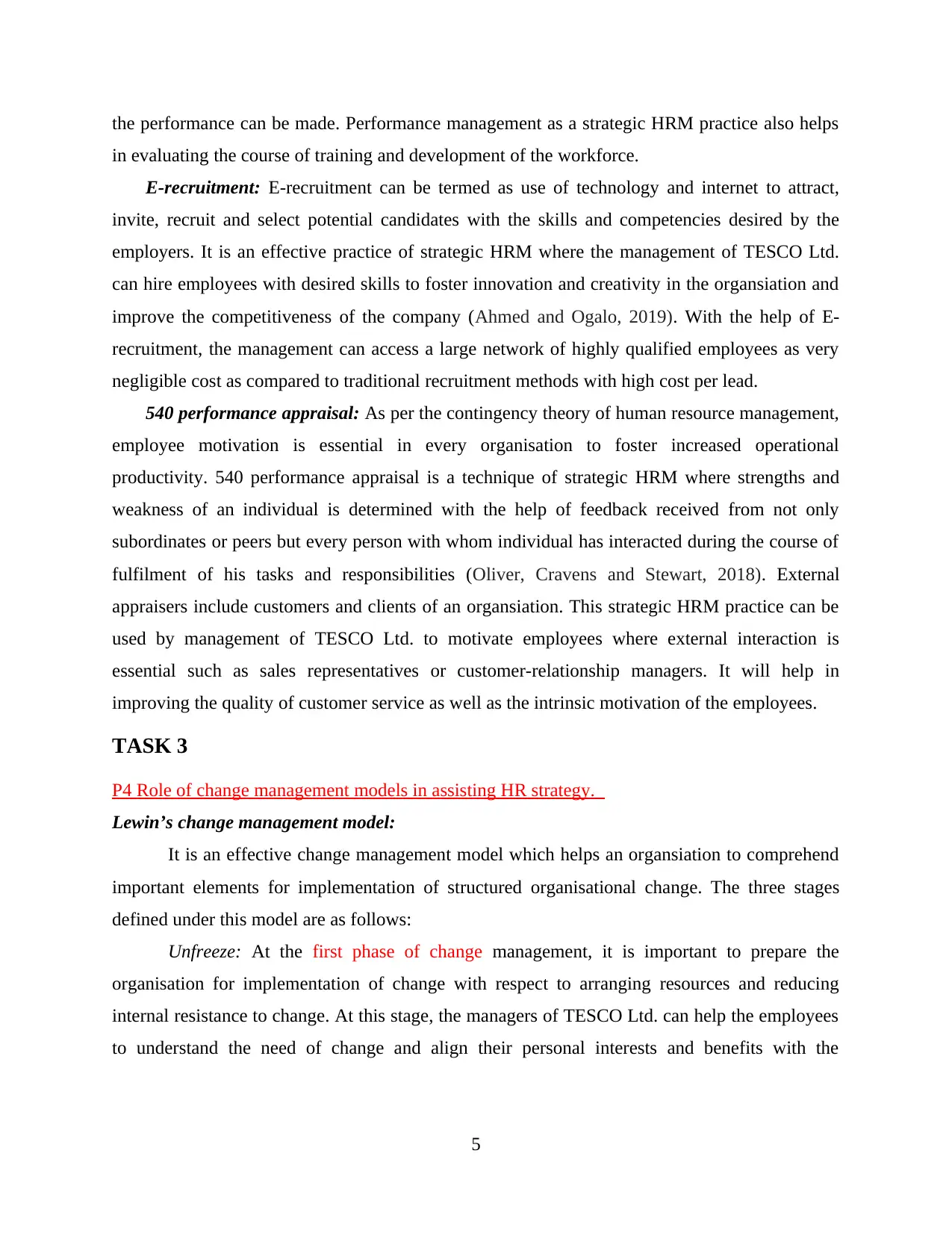
the performance can be made. Performance management as a strategic HRM practice also helps
in evaluating the course of training and development of the workforce.
E-recruitment: E-recruitment can be termed as use of technology and internet to attract,
invite, recruit and select potential candidates with the skills and competencies desired by the
employers. It is an effective practice of strategic HRM where the management of TESCO Ltd.
can hire employees with desired skills to foster innovation and creativity in the organsiation and
improve the competitiveness of the company (Ahmed and Ogalo, 2019). With the help of E-
recruitment, the management can access a large network of highly qualified employees as very
negligible cost as compared to traditional recruitment methods with high cost per lead.
540 performance appraisal: As per the contingency theory of human resource management,
employee motivation is essential in every organisation to foster increased operational
productivity. 540 performance appraisal is a technique of strategic HRM where strengths and
weakness of an individual is determined with the help of feedback received from not only
subordinates or peers but every person with whom individual has interacted during the course of
fulfilment of his tasks and responsibilities (Oliver, Cravens and Stewart, 2018). External
appraisers include customers and clients of an organsiation. This strategic HRM practice can be
used by management of TESCO Ltd. to motivate employees where external interaction is
essential such as sales representatives or customer-relationship managers. It will help in
improving the quality of customer service as well as the intrinsic motivation of the employees.
TASK 3
P4 Role of change management models in assisting HR strategy.
Lewin’s change management model:
It is an effective change management model which helps an organsiation to comprehend
important elements for implementation of structured organisational change. The three stages
defined under this model are as follows:
Unfreeze: At the first phase of change management, it is important to prepare the
organisation for implementation of change with respect to arranging resources and reducing
internal resistance to change. At this stage, the managers of TESCO Ltd. can help the employees
to understand the need of change and align their personal interests and benefits with the
5
in evaluating the course of training and development of the workforce.
E-recruitment: E-recruitment can be termed as use of technology and internet to attract,
invite, recruit and select potential candidates with the skills and competencies desired by the
employers. It is an effective practice of strategic HRM where the management of TESCO Ltd.
can hire employees with desired skills to foster innovation and creativity in the organsiation and
improve the competitiveness of the company (Ahmed and Ogalo, 2019). With the help of E-
recruitment, the management can access a large network of highly qualified employees as very
negligible cost as compared to traditional recruitment methods with high cost per lead.
540 performance appraisal: As per the contingency theory of human resource management,
employee motivation is essential in every organisation to foster increased operational
productivity. 540 performance appraisal is a technique of strategic HRM where strengths and
weakness of an individual is determined with the help of feedback received from not only
subordinates or peers but every person with whom individual has interacted during the course of
fulfilment of his tasks and responsibilities (Oliver, Cravens and Stewart, 2018). External
appraisers include customers and clients of an organsiation. This strategic HRM practice can be
used by management of TESCO Ltd. to motivate employees where external interaction is
essential such as sales representatives or customer-relationship managers. It will help in
improving the quality of customer service as well as the intrinsic motivation of the employees.
TASK 3
P4 Role of change management models in assisting HR strategy.
Lewin’s change management model:
It is an effective change management model which helps an organsiation to comprehend
important elements for implementation of structured organisational change. The three stages
defined under this model are as follows:
Unfreeze: At the first phase of change management, it is important to prepare the
organisation for implementation of change with respect to arranging resources and reducing
internal resistance to change. At this stage, the managers of TESCO Ltd. can help the employees
to understand the need of change and align their personal interests and benefits with the
5
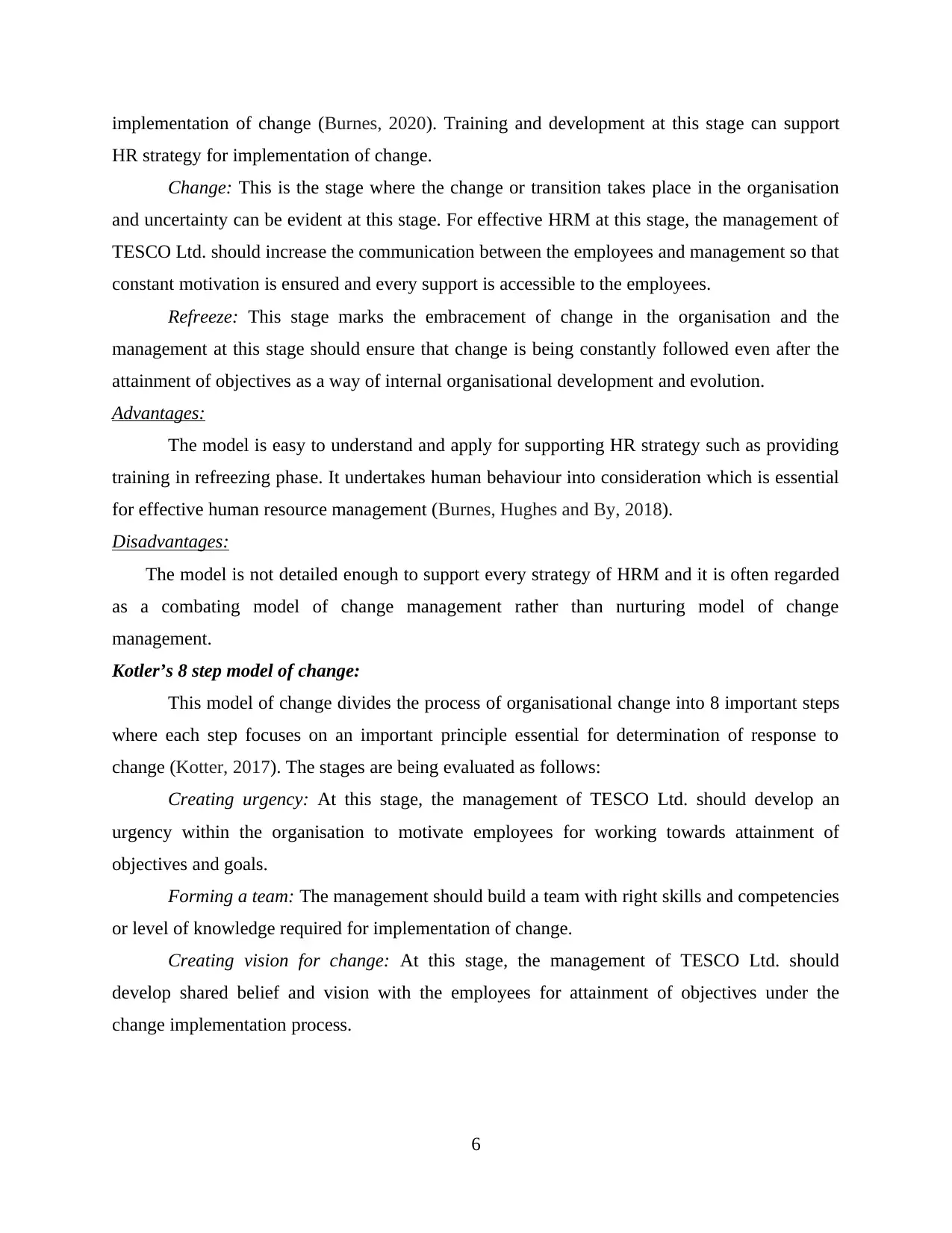
implementation of change (Burnes, 2020). Training and development at this stage can support
HR strategy for implementation of change.
Change: This is the stage where the change or transition takes place in the organisation
and uncertainty can be evident at this stage. For effective HRM at this stage, the management of
TESCO Ltd. should increase the communication between the employees and management so that
constant motivation is ensured and every support is accessible to the employees.
Refreeze: This stage marks the embracement of change in the organisation and the
management at this stage should ensure that change is being constantly followed even after the
attainment of objectives as a way of internal organisational development and evolution.
Advantages:
The model is easy to understand and apply for supporting HR strategy such as providing
training in refreezing phase. It undertakes human behaviour into consideration which is essential
for effective human resource management (Burnes, Hughes and By, 2018).
Disadvantages:
The model is not detailed enough to support every strategy of HRM and it is often regarded
as a combating model of change management rather than nurturing model of change
management.
Kotler’s 8 step model of change:
This model of change divides the process of organisational change into 8 important steps
where each step focuses on an important principle essential for determination of response to
change (Kotter, 2017). The stages are being evaluated as follows:
Creating urgency: At this stage, the management of TESCO Ltd. should develop an
urgency within the organisation to motivate employees for working towards attainment of
objectives and goals.
Forming a team: The management should build a team with right skills and competencies
or level of knowledge required for implementation of change.
Creating vision for change: At this stage, the management of TESCO Ltd. should
develop shared belief and vision with the employees for attainment of objectives under the
change implementation process.
6
HR strategy for implementation of change.
Change: This is the stage where the change or transition takes place in the organisation
and uncertainty can be evident at this stage. For effective HRM at this stage, the management of
TESCO Ltd. should increase the communication between the employees and management so that
constant motivation is ensured and every support is accessible to the employees.
Refreeze: This stage marks the embracement of change in the organisation and the
management at this stage should ensure that change is being constantly followed even after the
attainment of objectives as a way of internal organisational development and evolution.
Advantages:
The model is easy to understand and apply for supporting HR strategy such as providing
training in refreezing phase. It undertakes human behaviour into consideration which is essential
for effective human resource management (Burnes, Hughes and By, 2018).
Disadvantages:
The model is not detailed enough to support every strategy of HRM and it is often regarded
as a combating model of change management rather than nurturing model of change
management.
Kotler’s 8 step model of change:
This model of change divides the process of organisational change into 8 important steps
where each step focuses on an important principle essential for determination of response to
change (Kotter, 2017). The stages are being evaluated as follows:
Creating urgency: At this stage, the management of TESCO Ltd. should develop an
urgency within the organisation to motivate employees for working towards attainment of
objectives and goals.
Forming a team: The management should build a team with right skills and competencies
or level of knowledge required for implementation of change.
Creating vision for change: At this stage, the management of TESCO Ltd. should
develop shared belief and vision with the employees for attainment of objectives under the
change implementation process.
6
⊘ This is a preview!⊘
Do you want full access?
Subscribe today to unlock all pages.

Trusted by 1+ million students worldwide
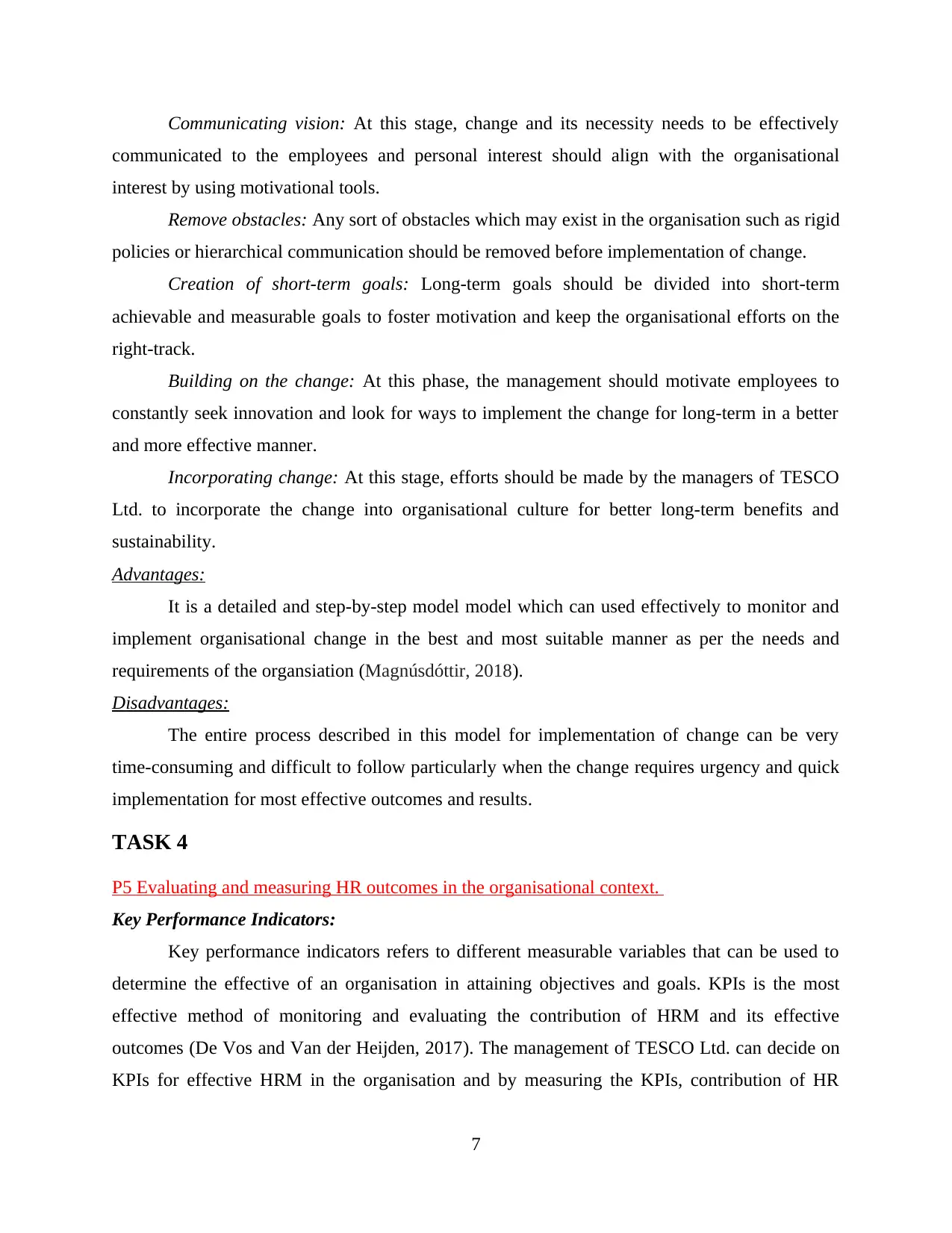
Communicating vision: At this stage, change and its necessity needs to be effectively
communicated to the employees and personal interest should align with the organisational
interest by using motivational tools.
Remove obstacles: Any sort of obstacles which may exist in the organisation such as rigid
policies or hierarchical communication should be removed before implementation of change.
Creation of short-term goals: Long-term goals should be divided into short-term
achievable and measurable goals to foster motivation and keep the organisational efforts on the
right-track.
Building on the change: At this phase, the management should motivate employees to
constantly seek innovation and look for ways to implement the change for long-term in a better
and more effective manner.
Incorporating change: At this stage, efforts should be made by the managers of TESCO
Ltd. to incorporate the change into organisational culture for better long-term benefits and
sustainability.
Advantages:
It is a detailed and step-by-step model model which can used effectively to monitor and
implement organisational change in the best and most suitable manner as per the needs and
requirements of the organsiation (Magnúsdóttir, 2018).
Disadvantages:
The entire process described in this model for implementation of change can be very
time-consuming and difficult to follow particularly when the change requires urgency and quick
implementation for most effective outcomes and results.
TASK 4
P5 Evaluating and measuring HR outcomes in the organisational context.
Key Performance Indicators:
Key performance indicators refers to different measurable variables that can be used to
determine the effective of an organisation in attaining objectives and goals. KPIs is the most
effective method of monitoring and evaluating the contribution of HRM and its effective
outcomes (De Vos and Van der Heijden, 2017). The management of TESCO Ltd. can decide on
KPIs for effective HRM in the organisation and by measuring the KPIs, contribution of HR
7
communicated to the employees and personal interest should align with the organisational
interest by using motivational tools.
Remove obstacles: Any sort of obstacles which may exist in the organisation such as rigid
policies or hierarchical communication should be removed before implementation of change.
Creation of short-term goals: Long-term goals should be divided into short-term
achievable and measurable goals to foster motivation and keep the organisational efforts on the
right-track.
Building on the change: At this phase, the management should motivate employees to
constantly seek innovation and look for ways to implement the change for long-term in a better
and more effective manner.
Incorporating change: At this stage, efforts should be made by the managers of TESCO
Ltd. to incorporate the change into organisational culture for better long-term benefits and
sustainability.
Advantages:
It is a detailed and step-by-step model model which can used effectively to monitor and
implement organisational change in the best and most suitable manner as per the needs and
requirements of the organsiation (Magnúsdóttir, 2018).
Disadvantages:
The entire process described in this model for implementation of change can be very
time-consuming and difficult to follow particularly when the change requires urgency and quick
implementation for most effective outcomes and results.
TASK 4
P5 Evaluating and measuring HR outcomes in the organisational context.
Key Performance Indicators:
Key performance indicators refers to different measurable variables that can be used to
determine the effective of an organisation in attaining objectives and goals. KPIs is the most
effective method of monitoring and evaluating the contribution of HRM and its effective
outcomes (De Vos and Van der Heijden, 2017). The management of TESCO Ltd. can decide on
KPIs for effective HRM in the organisation and by measuring the KPIs, contribution of HR
7
Paraphrase This Document
Need a fresh take? Get an instant paraphrase of this document with our AI Paraphraser
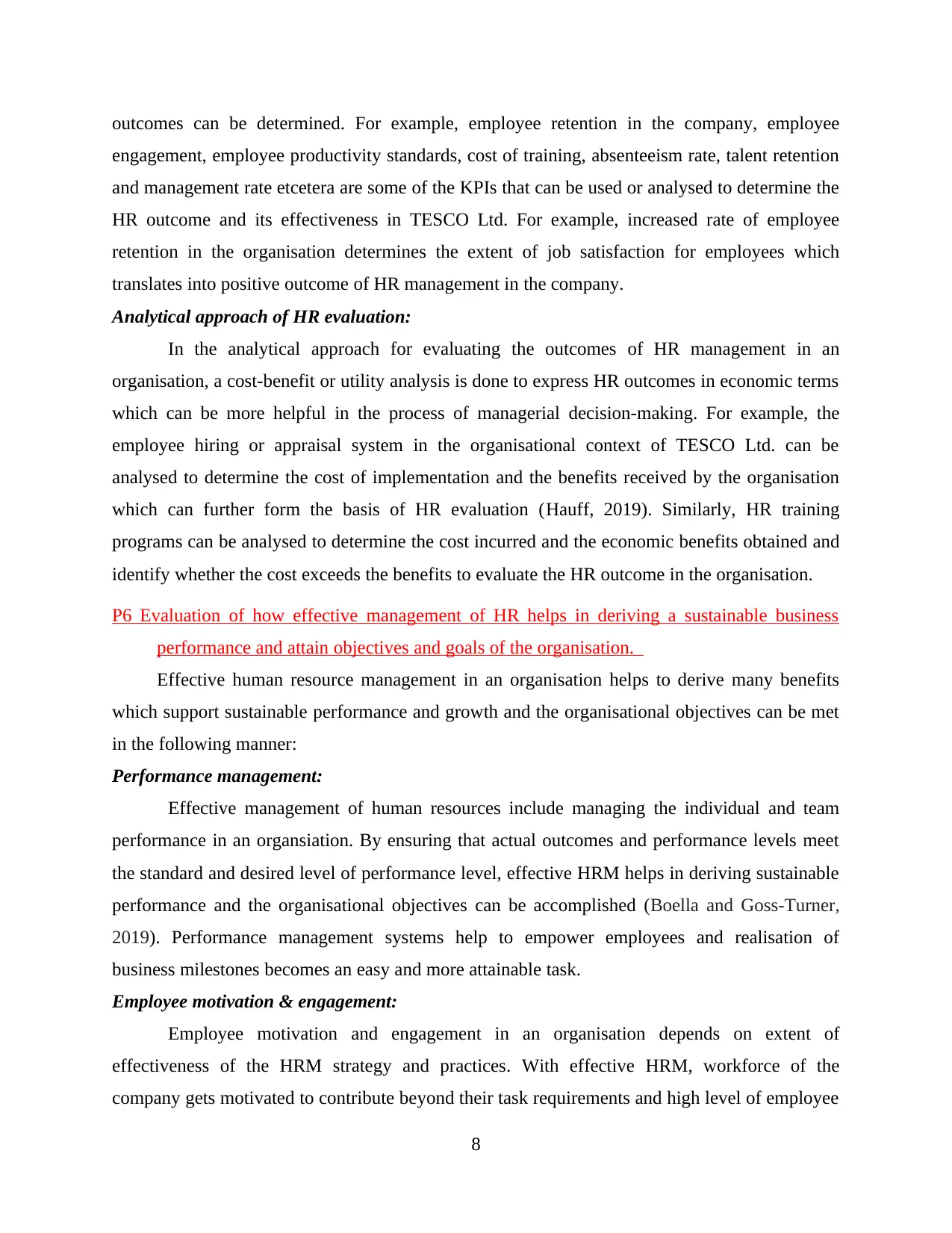
outcomes can be determined. For example, employee retention in the company, employee
engagement, employee productivity standards, cost of training, absenteeism rate, talent retention
and management rate etcetera are some of the KPIs that can be used or analysed to determine the
HR outcome and its effectiveness in TESCO Ltd. For example, increased rate of employee
retention in the organisation determines the extent of job satisfaction for employees which
translates into positive outcome of HR management in the company.
Analytical approach of HR evaluation:
In the analytical approach for evaluating the outcomes of HR management in an
organisation, a cost-benefit or utility analysis is done to express HR outcomes in economic terms
which can be more helpful in the process of managerial decision-making. For example, the
employee hiring or appraisal system in the organisational context of TESCO Ltd. can be
analysed to determine the cost of implementation and the benefits received by the organisation
which can further form the basis of HR evaluation (Hauff, 2019). Similarly, HR training
programs can be analysed to determine the cost incurred and the economic benefits obtained and
identify whether the cost exceeds the benefits to evaluate the HR outcome in the organisation.
P6 Evaluation of how effective management of HR helps in deriving a sustainable business
performance and attain objectives and goals of the organisation.
Effective human resource management in an organisation helps to derive many benefits
which support sustainable performance and growth and the organisational objectives can be met
in the following manner:
Performance management:
Effective management of human resources include managing the individual and team
performance in an organsiation. By ensuring that actual outcomes and performance levels meet
the standard and desired level of performance level, effective HRM helps in deriving sustainable
performance and the organisational objectives can be accomplished (Boella and Goss-Turner,
2019). Performance management systems help to empower employees and realisation of
business milestones becomes an easy and more attainable task.
Employee motivation & engagement:
Employee motivation and engagement in an organisation depends on extent of
effectiveness of the HRM strategy and practices. With effective HRM, workforce of the
company gets motivated to contribute beyond their task requirements and high level of employee
8
engagement, employee productivity standards, cost of training, absenteeism rate, talent retention
and management rate etcetera are some of the KPIs that can be used or analysed to determine the
HR outcome and its effectiveness in TESCO Ltd. For example, increased rate of employee
retention in the organisation determines the extent of job satisfaction for employees which
translates into positive outcome of HR management in the company.
Analytical approach of HR evaluation:
In the analytical approach for evaluating the outcomes of HR management in an
organisation, a cost-benefit or utility analysis is done to express HR outcomes in economic terms
which can be more helpful in the process of managerial decision-making. For example, the
employee hiring or appraisal system in the organisational context of TESCO Ltd. can be
analysed to determine the cost of implementation and the benefits received by the organisation
which can further form the basis of HR evaluation (Hauff, 2019). Similarly, HR training
programs can be analysed to determine the cost incurred and the economic benefits obtained and
identify whether the cost exceeds the benefits to evaluate the HR outcome in the organisation.
P6 Evaluation of how effective management of HR helps in deriving a sustainable business
performance and attain objectives and goals of the organisation.
Effective human resource management in an organisation helps to derive many benefits
which support sustainable performance and growth and the organisational objectives can be met
in the following manner:
Performance management:
Effective management of human resources include managing the individual and team
performance in an organsiation. By ensuring that actual outcomes and performance levels meet
the standard and desired level of performance level, effective HRM helps in deriving sustainable
performance and the organisational objectives can be accomplished (Boella and Goss-Turner,
2019). Performance management systems help to empower employees and realisation of
business milestones becomes an easy and more attainable task.
Employee motivation & engagement:
Employee motivation and engagement in an organisation depends on extent of
effectiveness of the HRM strategy and practices. With effective HRM, workforce of the
company gets motivated to contribute beyond their task requirements and high level of employee
8
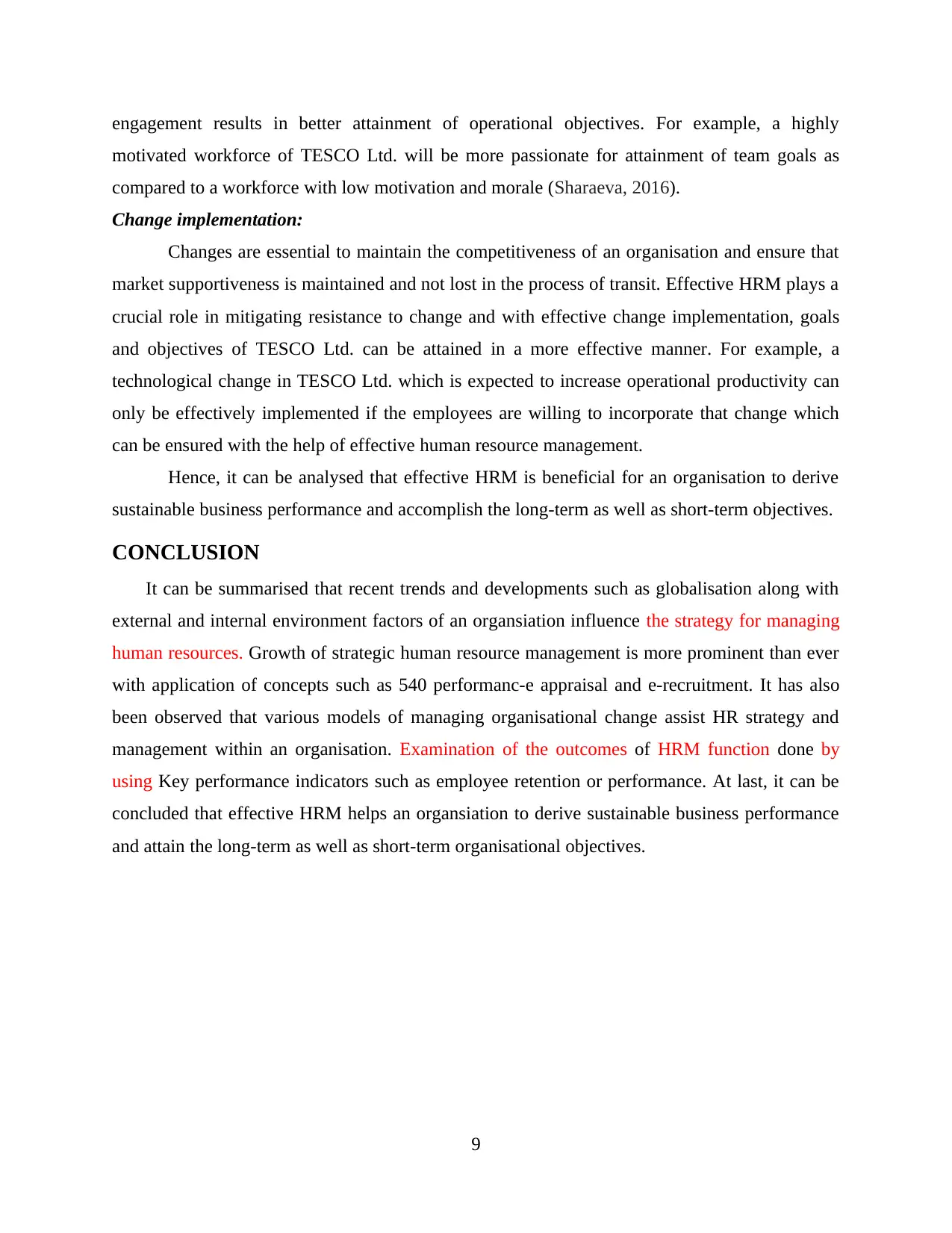
engagement results in better attainment of operational objectives. For example, a highly
motivated workforce of TESCO Ltd. will be more passionate for attainment of team goals as
compared to a workforce with low motivation and morale (Sharaeva, 2016).
Change implementation:
Changes are essential to maintain the competitiveness of an organisation and ensure that
market supportiveness is maintained and not lost in the process of transit. Effective HRM plays a
crucial role in mitigating resistance to change and with effective change implementation, goals
and objectives of TESCO Ltd. can be attained in a more effective manner. For example, a
technological change in TESCO Ltd. which is expected to increase operational productivity can
only be effectively implemented if the employees are willing to incorporate that change which
can be ensured with the help of effective human resource management.
Hence, it can be analysed that effective HRM is beneficial for an organisation to derive
sustainable business performance and accomplish the long-term as well as short-term objectives.
CONCLUSION
It can be summarised that recent trends and developments such as globalisation along with
external and internal environment factors of an organsiation influence the strategy for managing
human resources. Growth of strategic human resource management is more prominent than ever
with application of concepts such as 540 performanc-e appraisal and e-recruitment. It has also
been observed that various models of managing organisational change assist HR strategy and
management within an organisation. Examination of the outcomes of HRM function done by
using Key performance indicators such as employee retention or performance. At last, it can be
concluded that effective HRM helps an organsiation to derive sustainable business performance
and attain the long-term as well as short-term organisational objectives.
9
motivated workforce of TESCO Ltd. will be more passionate for attainment of team goals as
compared to a workforce with low motivation and morale (Sharaeva, 2016).
Change implementation:
Changes are essential to maintain the competitiveness of an organisation and ensure that
market supportiveness is maintained and not lost in the process of transit. Effective HRM plays a
crucial role in mitigating resistance to change and with effective change implementation, goals
and objectives of TESCO Ltd. can be attained in a more effective manner. For example, a
technological change in TESCO Ltd. which is expected to increase operational productivity can
only be effectively implemented if the employees are willing to incorporate that change which
can be ensured with the help of effective human resource management.
Hence, it can be analysed that effective HRM is beneficial for an organisation to derive
sustainable business performance and accomplish the long-term as well as short-term objectives.
CONCLUSION
It can be summarised that recent trends and developments such as globalisation along with
external and internal environment factors of an organsiation influence the strategy for managing
human resources. Growth of strategic human resource management is more prominent than ever
with application of concepts such as 540 performanc-e appraisal and e-recruitment. It has also
been observed that various models of managing organisational change assist HR strategy and
management within an organisation. Examination of the outcomes of HRM function done by
using Key performance indicators such as employee retention or performance. At last, it can be
concluded that effective HRM helps an organsiation to derive sustainable business performance
and attain the long-term as well as short-term organisational objectives.
9
⊘ This is a preview!⊘
Do you want full access?
Subscribe today to unlock all pages.

Trusted by 1+ million students worldwide
1 out of 14
Related Documents
Your All-in-One AI-Powered Toolkit for Academic Success.
+13062052269
info@desklib.com
Available 24*7 on WhatsApp / Email
![[object Object]](/_next/static/media/star-bottom.7253800d.svg)
Unlock your academic potential
Copyright © 2020–2025 A2Z Services. All Rights Reserved. Developed and managed by ZUCOL.





